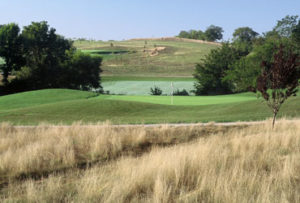Erik Larsen, ASGCA and Victoria Martz, ASGCA, together with golf course builder Landscapes Unlimited, teamed up with the National Arbor Day Foundation to build Arbor Links Golf Course in Nebraska City, Nebraska, as an educational model for a sustainable and affordable course. In building Arbor Links, the team’s goals included: conservation of wildlife habitat, protection and improvement of water quality in creeks and watersheds, and restoration of degraded prairie.
Arbor Links Golf Course was built on 300 acres of land adjacent to the Lied Conference Center at Arbor Day Farms. The site’s existing prairie land and natural creeks were degraded by earlier farming practices; the main creek running through the land was badly eroded, and its water quality had been compromised by heavy agronomic use; native grassland had been overgrown; and wildlife habitat had become diminished. Taking these things into consideration, the design team decided on a natural routing and concept to incorporate and protect what they could of the site.

Arbor Links Golf Course, Nebraska City, Nebraska
The golf course architects used bunkers with ragged edges to provide a compatible appearance for the windswept prairie look of Nebraska. They also restored indigenous prairie grasses to enhance wildlife habitat and to reduce the amount of irrigation required. Corridors of vegetation and food plots were incorporated as well, connecting habitat areas of different animal and bird species and encouraging wildlife.
The creek running through the site was also restored to its original direction, and methods were taken to stabilize its banks and prevent erosion.Replacing the need for sod on tee slopes, lake edges, and green banks, forty acres of erosion matting was used to assist seed germination and prevent runoff in potential wash areas. A buffer system of vegetation was implemented too, filtering runoff from the golf course. This vegetation can also be harvested periodically as biomass for energy production for the conference center.
Larsen, Martz, and Landscapes Unlimited teamed with Arbor Day Farms to implement a tree planting program around the course. This restoration of prairie, wetland, and forest was accomplished by planting varieties of native tree species, which reestablished a natural wind screen and provided habitat.
The design team and Arbor Day Farms elected to provide opportunities for education and research sharing on the course as well. An agronomic staff continually studies turf characteristics, rate of growth, and playing conditions of the greens to detect performance differences and effects. A golf course pocket guide was also developed to educate golfers on the conservation methods employed during the design and construction, and to provide information regarding sustainable maintenance techniques.
Arbor Links Golf Course was designed and built and is now maintained to meet the partnership’s initial environmental vision. Continually recognized as a national environmental model, the course truly is an example of sustainable design and is a wonderful educational resource for the community and golfers.
To read more Environmental Case Studies, please visit here.
